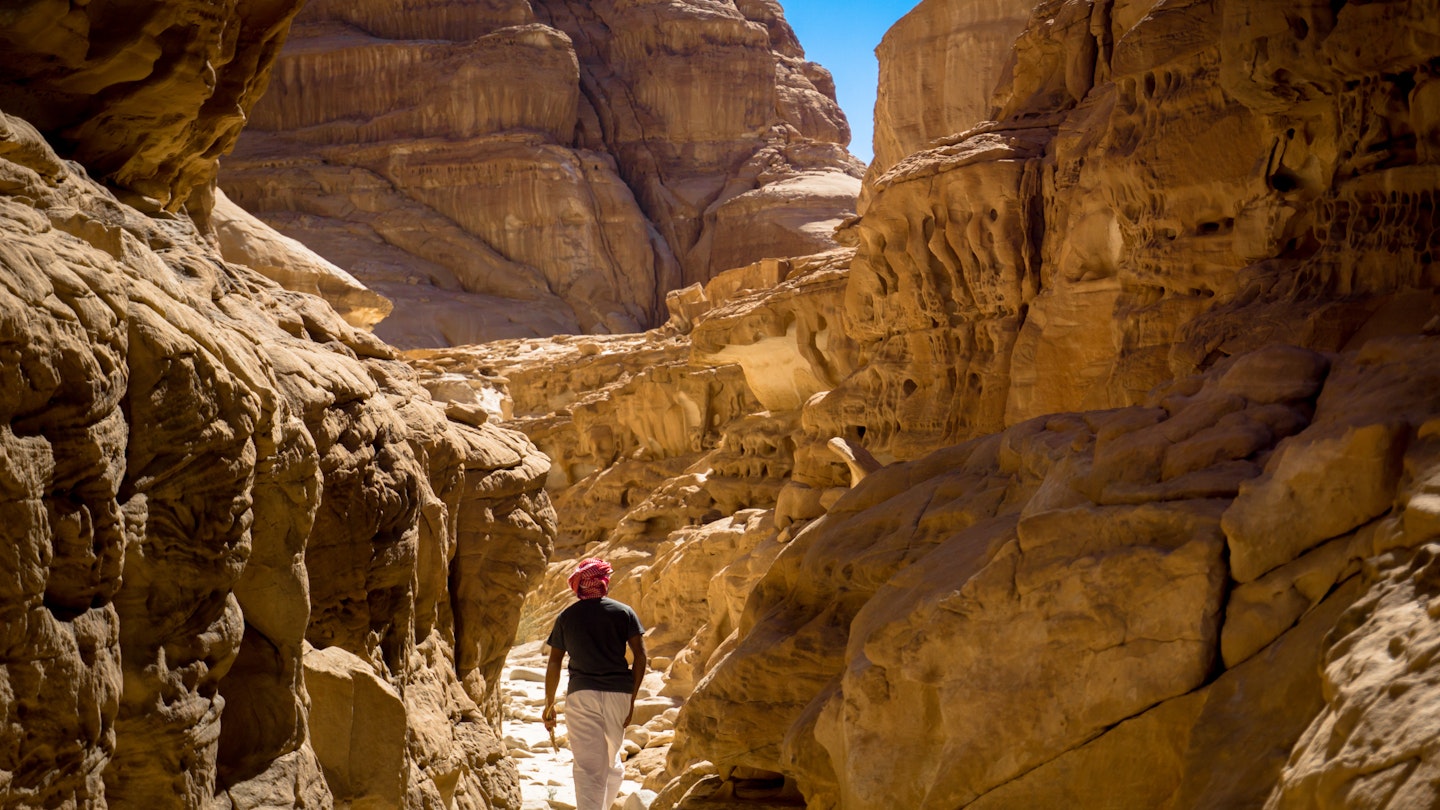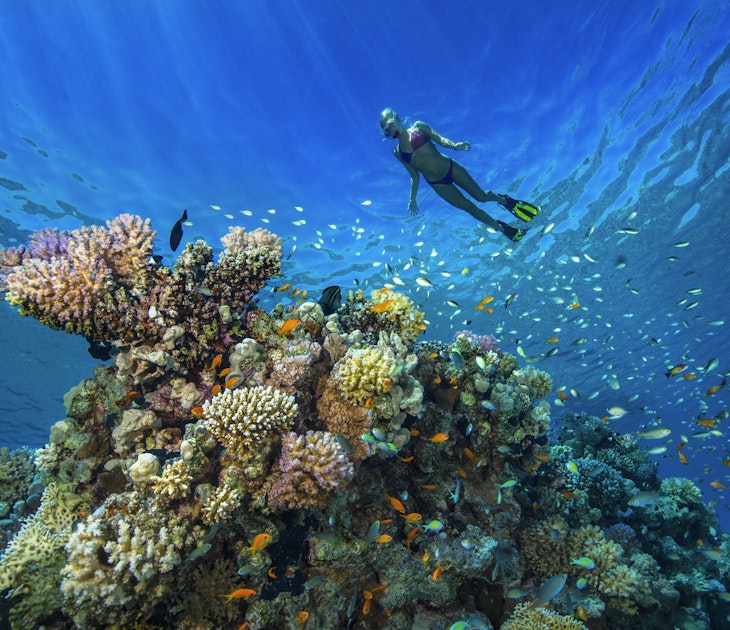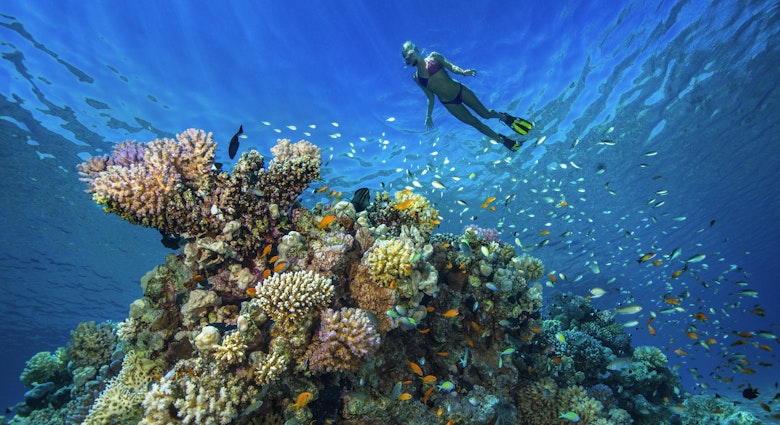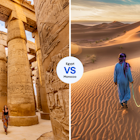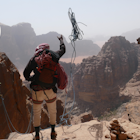For desert trekking, Egypt is tough to beat. Bedouin-led hiking trips in the Sinai Peninsula and Red Sea Mountains provide opportunities to explore two of the Middle East’s most rugged wildernesses while also gaining insights into Bedouin heritage.
Despite the tough terrain, hiking isn’t only for the highly experienced. Mount Sinai has trails for everyone and is regularly summited by complete beginners. Even on Egypt’s two long-distance trails, shorter itineraries are suitable for casual hikers with a high fitness level.
Guides are mandatory on most treks due to the harsh, remote environment, where local knowledge is key to safe hiking and for acquiring the necessary permissions. Here's our list of the best hikes in Egypt.
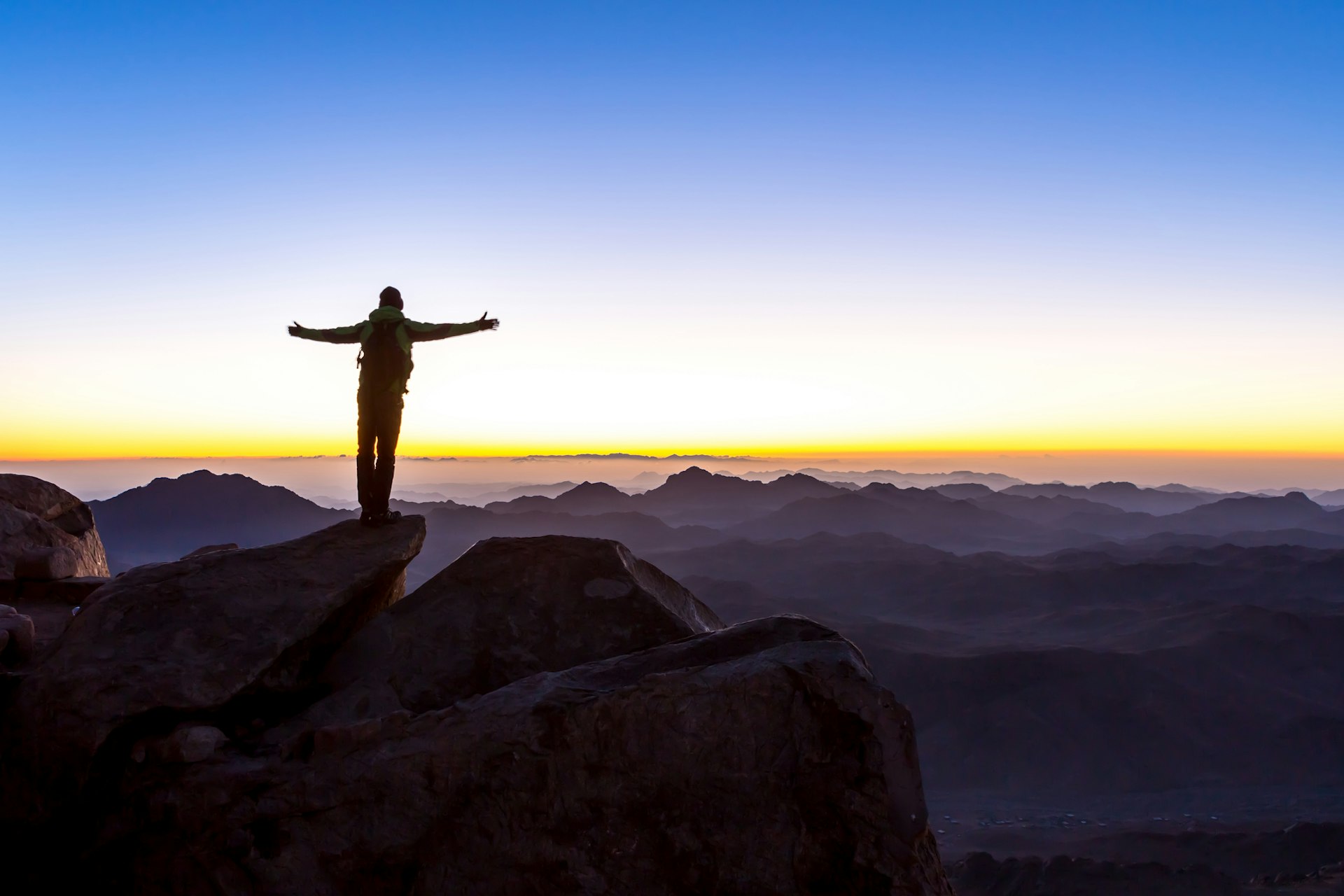
Mount Sinai (Gebel Musa) Summit
Best easy summit
6.2miles (10km) round-trip, 4-5 hours, easy to moderate
Hiking to the 2285m (7496ft) summit of Mount Sinai (Gebel Musa) is extremely popular with outdoor enthusiasts and pilgrimage tourists. Mount Sinai is where believers say Moses received the Ten Commandments.
The easiest route is the Camel Trail, a wide, well-defined switchback path up the furrowed slope that ascends at a steady gradient to Elijah’s Basin. The trailhead is right in front of St Katherine’s Monastery at the foot of the mountain. The track is gravelly underfoot, particularly at the higher reaches, but is otherwise a straightforward walk.
The Steps of Repentance
Mount Sinai’s second trail is the Steps of Repentance which begins behind the monastery. Built by one of St Katherine’s monks as an act of penance, this is a steeper, more direct route of 3750 rough-cut stone steps.
With expansive views of the craggy contours of the surrounding mountains and – if you’re lucky – a glimpse of a mountain ibex along the way, the knee-wearying stairs are worth it. If your knees aren’t up to it, hike the easier Camel Trail up and take the Steps of Repentance down.
The Wadi Arbain Trail
The less basic third option is the Wadi Arbain Trail. This route begins in the spring-fed wadi (valley) behind St Katherine village, passing the Monastery of Forty Martyrs (Deir Arbain) and the large boulder known as the Rock of Moses where, according to local tradition, Moses struck with his staff to produce water.
From here you traverse a narrow, stony-underfoot track, scattered with early Christian hermit cells, up the neighboring slope of Gebel Safsafa until it connects with the final switchback of the Camel Trail.
All three trails converge at Elijah's Basin, a small plateau where believers say the Prophet Elijah waited for God. From here, everyone hikes the final 750 stairs of the Steps of Repentance to Mount Sinai’s summit. Guides are mandatory on all Mount Sinai routes. This provides much-needed work for St Katherine’s Jabaliyya Bedouin tribe.
If you want to hike the Camel Trail or Steps of Repentance, simply turn up at the Mount Sinai-St Katherine’s Monastery visitor center, and you’ll be assigned a guide (USD $20) on the spot. The Wadi Arbain Trail is organized through local St Katherine trekking outfits such as Sheikh Mousa Guesthouse or Wilderness Ventures Egypt.
The best places to visit in Egypt

Blue Hole to Ras Abu Gallum hike
Best easy coastal hike
5 miles (8km) one-way, 1.5 hours, easy
This trail skims the narrow shoreline from Dahab’s Blue Hole bay into the national park of Ras Abu Gallum. Despite a lack of signage or way-marking, it’s easily hiked independently and navigational skills aren’t necessary. You’re simply following the thin thread of coast, squeezed between rocky cliffs to the west and the Red Sea to the east. The path is rocky underfoot but mostly flat and well-defined.
At the hike's northern end, within Ras Abu Gallum, several Bedouin beach-camps are scattered along the sand, up to the curved cove of the Blue Lagoon. The camps provide meals and basic, back-to-nature hoosha (palm-thatch) hut accommodation if you want to stay the night before hiking back.
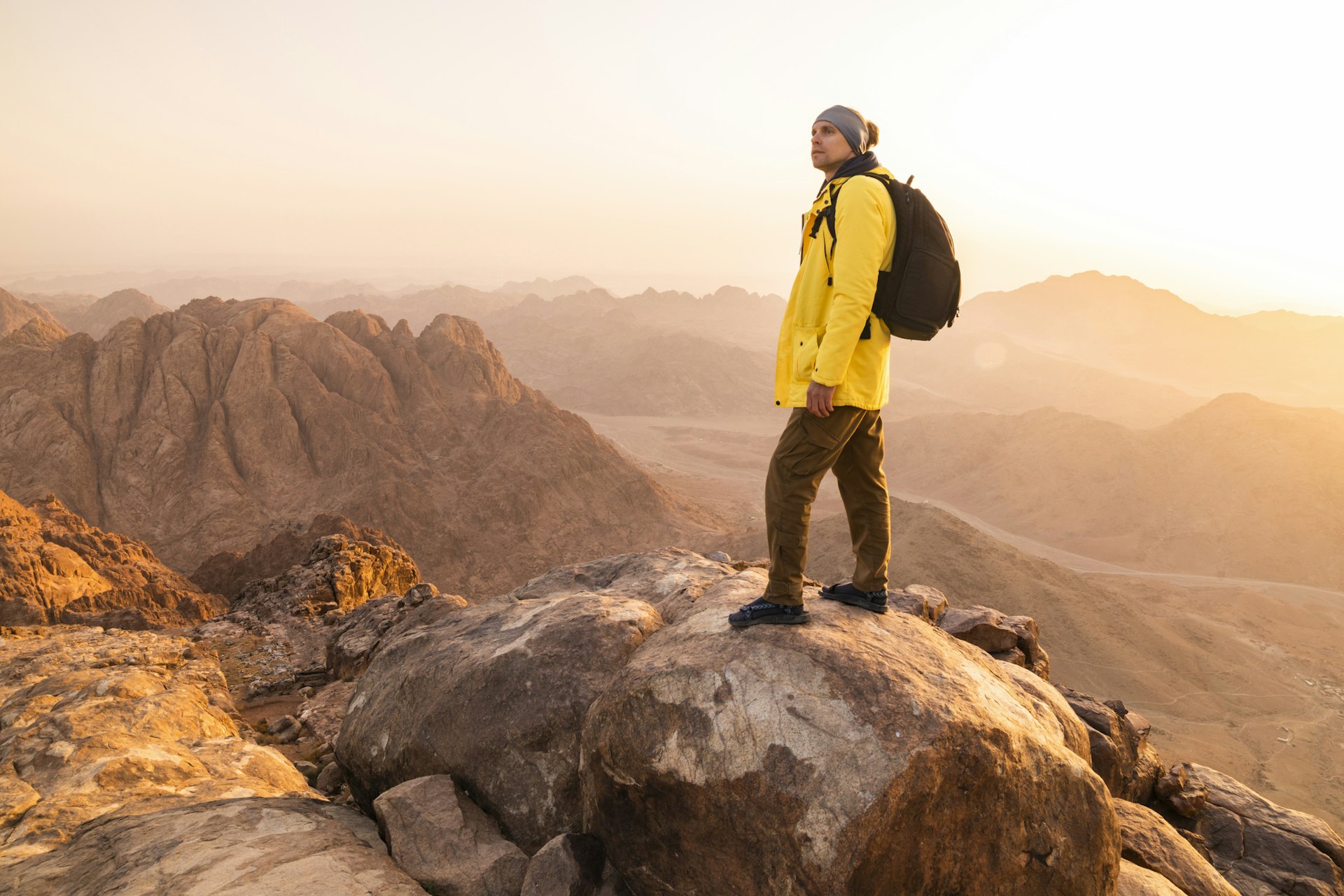
The Sinai Trail
Best multi-day desert trekking
340miles (550km) long-distance circuit, 54 days, moderate-difficult
The Sinai Trail is a circuit of four interconnecting trails that trace a rough triangle using centuries-old routes utilized by Bedouin-guided pilgrims, traders, and smugglers. The trail is a community-tourism project operated by eight of the peninsula’s Bedouin tribes who organize and guide all trips, allowing hikers a rare chance to experience traditional Bedouin culture while also providing fair-paid employment and opportunities for Bedouin communities.
The original 12-day, 130-mile (210km) Ras Shetan to St Katherine section is a moderate-level trek. You need a high level of fitness and stamina as you’ll be hiking long distances through sand (wearying on feet) and over rocky ground.
Over the first portion of the trek, you’ll traverse stark coastal plains speckled with tiny spring-fed oases and hike through the orange and pink swirled walls of South Sinai's Colored Canyon.
Further into the highlands, the terrain gets rougher, following deep gorges and wide desert passes punctured by vast rock-outcrops, into the High Mountains. On the trek's last two days, hikers summit Mount Sinai and Gebel Katarina for views of rolling waves of jagged-edged peaks stretching out below.
Local knowledge and support are essential for trekking Sinai Trail routes and hikes. Cameleers and camels accompany visitors to transport larger bags, camping equipment, food, and water.
The best time to visit Egypt to avoid the heat

Red Sea Mountain Trail
Best remote day-hiking
105 miles (170km) long-distance circuit, 10-days, moderate-difficult
Opened in 2019, the Red Sea Mountain Trail (RSMT) cuts through the coastal mountain range which scythes across the Red Sea coast, inland from Hurghada. Due both to Covid and slow-moving bureaucracy approving overnight permits in this area, the trail is currently operating on a day-hike basis, though multi-day treks are pegged to begin at some stage in 2022.
As with its sister Sinai Trail, the RSMT is focused on introducing a sustainable form of tourism that benefits more isolated communities. The trail is operated by the local Maaza Bedouin tribe members who provide mandatory guides and the support necessary to hike out into this harsh, remote region.
Day hikes range from an easygoing 3 miles (5km) trek to the ruins of the Roman quarry-town of Mons Claudianus to a moderate 10.5 miles (17km) trail that crosses the narrow canyons and steep mountain passes of the Gebel Abul Hassan massif. Most day-hike trailheads are a 90-minute or two-hour drive from Hurghada and are easily accessible from the Red Sea coast’s major city.
Wadi Degla Protectorate
Best easy hike near Cairo
8-13km (5-8mi) round-trip trails, 2-4 hours, easy
If you need to grab a breather from Cairo’s car-horn cacophony, beeline to the Wadi Degla Protectorate on the eastern edge of the Cairo suburb of Maadi, 6 miles (10km) from Maadi metro station. This arid valley meanders for 22 miles (37km), rimmed by low, weathered limestone cliffs, whittled away by wind and water erosion over millions of years.
Wadi Degla is a beacon for Cairene outdoor enthusiasts who come here to hike, run, and mountain bike on the well-defined trails and picnic at designated camping grounds.
Unsurprisingly, as it’s on the doorstep of one of Africa’s greatest cities, Wadi Degla is not the most peaceful hiking experience on the planet. Your best chance to spot some of the valley’s red foxes, cape hare, and deer, is to come on a weekday when there are far fewer visitors.
The 8-mile (13km) trail of the Wadi Degla Loop winds upwards from the valley basin to cross the clifftops and offers great views of the rocky expanse below. For the most serene hiking, connect this with the Wadi Degla Deep Loop which heads deeper into Wadi Degla (beyond all the camping sites) for a 2.5-mile (4km) flat ramble that simply follows the valley floor.
The best months to visit are from February to April when you should keep your eyes peeled to spy sooty falcons, which return here to breed each spring.
Tips for hiking in Eygpt
- Hiking is generally viable in Egypt from September to May.
- Mid-February to mid-March and mid-October through November are peak times to visit. In spring, the desert floor blooms into life. Fall is when the light is at its softest.
- If tackling multi-day routes in the Sinai and along the Red Sea coast, gear up before arrival. A good-quality sleeping bag and mat are essential. Most hikers will also want to bring a lightweight tent to protect against mosquitos, scorpions, rain, and cold. Camels will carry these as you hike.
- Both the Sinai Trail and the RSMT (when it opens for multi-day hiking) organize group treks along their trails which are a great option for solo travelers. Check their Facebook pages for the latest dates.
- St Katherine, in the Sinai, is Egypt’s hiking hub. Plenty of day-hike and multi-day trekking options can be arranged with the Bedouin trekking operators there.
You might also like:
Experience Egypt’s epic history via these latest discoveries
The best things to do in Egypt
Getting to know the pyramids of Giza
